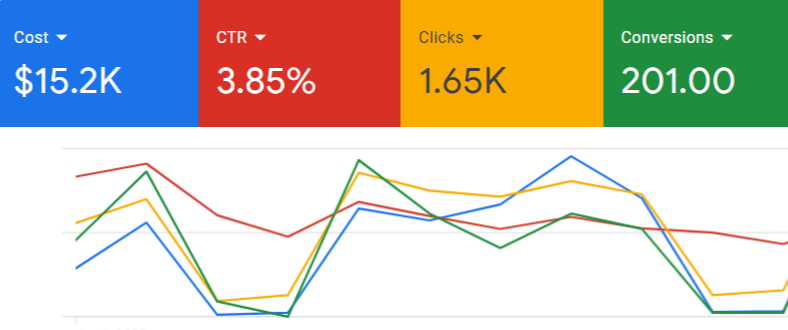Are you striving to optimize your Google Ads campaigns for better performance and higher return on investment? Understanding the average CTR for Google. Ads are crucial to achieving this goal. With CTR being a key metric in determining the success of your online advertising efforts, it’s imperative to know how your campaigns stack up against industry benchmarks and what strategies can boost your average CTR for your Google Ads campaign.
In this blog post, you’ll gain insights into the world of Google Ads CTR, learning how it’s calculated, the factors that affect it, and the differences between Search Network and Display Network CTRs. We’ll also reveal the top-performing and underperforming industries, discuss strategies to improve your average CTR for Google Ads, and analyze performance metrics such as conversion rates, cost-per-click (CPC), and cost-per-acquisition (CPA). Buckle up and get ready to elevate your Google Ads campaigns!
Short Summary
- Google Ads CTR is a key metric used to measure the success of campaigns, and varies based on ad position, relevance to search query & more.
- Search Network CTRs are typically higher than Display Network CTRs due to user intent differences between platforms.
- Strategies such as refining ad targeting, enhancing copy & utilizing extensions can help improve Google Ads performance metrics for better ROI.
Understanding Google Ads CTR

Click-through rate (CTR) is a vital metric in the realm of digital advertising, reflecting the effectiveness of your ads by measuring the ratio of clicks to ad views. A high CTR is a boon for your Google Ads campaigns, as it can lead to higher ad quality scores and conversion rates.
But what factors can influence your CTR, and how can you ensure that your ads are hitting the mark? In order to unlock the full potential of your campaigns and achieve success in the competitive landscape of Google Ads, it’s essential to grasp the intricacies of CTR calculation and the factors that impact it.
By analysing Google. Ads industry benchmarks, you can gain a better understanding of how your ads perform compared to competitors. Let’s dive deeper into the nuances of CTR and the factors that affect it.
How is CTR calculated?
CTR, or Click-Through Rate, is a powerful metric employed to gauge the efficiency and success of an online advertising campaign. The formula for calculating CTR in Google Ads is simple: divide the number of clicks on the ad by the total number of impressions, then express the result as a percentage. Essentially, it measures the attractiveness of your ad to your target audience.
While the average click-through rate for Google Ads varies across industries, it typically falls between 3 and 5%. This range serves as a benchmark that can help you evaluate your ads performance and identify areas for improvement. By comparing your campaign’s performance to average click through rates, you can better understand how well your ads are resonating with your target audience.
By understanding how CTR is measured, you can make informed decisions to optimize your campaigns and drive better results.
Factors affecting CTR
Several factors can influence the click-through rate of your Google Ads, such as ad position, ad relevance to the search query, site link extensions, industry, keyword, and location of the link, among others. Ad relevance, for instance, plays a crucial role in determining the success of your ads. Ads with greater relevance to the search query are more likely to be clicked.
Another critical factor is targeting, which involves selecting appropriate keywords, locations, and other criteria to ensure your ads are visible to the intended recipients. Moreover, ads copy and ads extensions can also impact your CTR. By understanding and addressing these factors, you can significantly improve your Google Ads CTR and, in turn, the overall performance of your campaigns.
Search Network vs. Display Network CTRs

When it comes to Google Ads, it’s important to distinguish between search and display ads, as these two advertising platforms yield different CTRs. The Search Network comprises search engine results pages where ads are displayed, while the Display Network consists of websites that have partnered with Google to show targeted ads on their own landing pages.
But what causes the disparity in CTR between these two networks? The key to understanding this difference lies in the user intent. Users on the Search Network are actively looking for information, whereas those on the Display Network are engaged in other online activities. This difference in user behavior results in higher click-through rates, conversion rates, average cost per click, and other performance metrics for the Search Network compared to the Display Network.
Let’s take a closer look at the average ctr for both networks.
Search Network CTRs
The Google Search Network is designed for text-based advertisements, which are typically placed above and to the right of normal search engine results pages. With users actively searching for information, the Search Network tends to yield higher CTRs for ads, as they are more likely to be clicked by users who are genuinely interested in the content. This makes it an ideal platform for paid search campaigns.
On the Search Network, the average Google Ads click-through rate across all industries is 5.06%. This higher CTR can be attributed to the higher intent of users on the Search Network, as they are actively seeking solutions to their queries and are more likely to click on relevant ads.
Display Network CTRs
The Google Display Network, on the other hand, consists of websites that have partnered with Google to show targeted ads on their pages. Google display ads are typically shown to users while they are engaged in other activities online, such as browsing the web or consuming content. Consequently, the CTRs for Display Network ads are generally lower than those for Search Network ads.
In fact, the average Google Ads click-through rate across all industries is only 0.50% on the Display Network. This lower CTR can be partially explained by the passive nature of users on the Display Network, who are less likely to click on ads as they are not actively searching for information or solutions.
Industry Benchmarks for Google Ads CTR

To gain a better understanding of your Google Ads performance, it’s essential to compare your CTR with google adwords industry benchmarks. These benchmarks can provide insights into whether your ads are performing above or below average, helping you identify areas for improvement and optimization.
In this section, we’ll delve into the industry benchmarks for Google Ads CTR, highlighting the top-performing industries and those that are underperforming. By comparing your own CTR with these benchmarks, you can gauge the success of your campaigns and uncover opportunities to boost your performance.
Top-performing industries
Some industries consistently outperform others when it comes to Google Ads CTR on the Search Network. The travel & tourism, vehicles, dining & nightlife, and real estate industries are among the top performers in terms of CTR.
These industries tend to have higher click-through rates due to the nature of their products and services, which typically align with users’ high-intent searches. By learning from the strategies employed by top-performing industries, you can potentially replicate their success and improve your own CTR.
Underperforming industries
On the other hand, some industries consistently underperform when it comes to Google Ads CTR. Law & government, computers & computer electronics, and finance are currently struggling on the Search Network, showcasing the varying performance of Google Ads by industry.
Industries with low CTRs may face challenges such as high competition, low relevance to users’ searches, or poor ad targeting strategies. To improve CTR for underperforming industries, it’s important to analyze the factors contributing to low performance and implement strategies that address these issues.
Strategies to Improve Google Ads CTR

Now that we’ve explored the factors that influence CTR and the differences between Search Network and Display Network CTRs, it’s time to discuss strategies that can help you improve your Google Ads CTR. By effectively implementing these strategies, you can boost your ad performance, increase your quality score, and ultimately, drive better results for your campaigns.
In this section, we’ll cover three key strategies for improving Google Ads CTR: refining ad targeting, enhancing ads copy, and utilizing ads extensions. By mastering these techniques, you can optimize your campaigns and achieve higher CTRs.
Refining ad targeting
One of the most effective ways to improve your Google Ads CTR is to refine your ad targeting within your Google Ads account. By ensuring that your ads are displayed to the right audience, you can increase their relevance and the likelihood of users clicking on them. Utilizing Google AdWords can further enhance your ad performance and reach.
To refine your ad targeting, consider incorporating negative keywords, optimizing ad relevance to keywords, and leveraging smart bidding strategies. By doing so, you can reduce irrelevant clicks, improve your CTR, and ensure that your ads are reaching the right audience at the right time.
Enhancing ad copy
Another crucial strategy for improving your Google Ads CTR is enhancing your ad copy. Compelling, relevant, and engaging ads can significantly impact the success of your ads, encouraging users to click on them and explore your offerings.
To improve your ad copy, consider testing different ad types, crafting persuasive ad copy, and ensuring that your ads are relevant to the associated keywords. By fine-tuning your ad copy and tailoring it to your target audience, you can increase your CTR and drive better results from your campaigns.
Utilizing ad extensions
Ad extensions are additional elements that can be incorporated into your ads, such as site links, call-to-action buttons, and more. Utilizing ads extensions can significantly improve the visibility and click-through rate of your ads, ultimately boosting your campaign performance.
Examples of ads extensions include call extensions, location extensions, and review extensions, among others. By optimizing your ads, you can provide users with more information about your products or services, increasing the likelihood of them clicking on your ads and improving your overall CTR.
Analyzing Google Ads Performance Metrics

In addition to improving your CTR, it’s essential to analyze other performance metrics in your Google Ads campaigns to measure success and optimize your efforts. By examining metrics such as conversion rates, cost-per-click (CPC), and cost-per-acquisition (CPA), you can gain a deeper understanding of your campaign performance and identify areas for improvement.
In this section, we’ll discuss these performance metrics in greater detail, highlighting their significance in evaluating the success of your Google Ads campaigns and providing insights on how to optimize them.
Conversion Rates
Conversion rates are a critical metric in the world of digital advertising, as they indicate the percentage of website visitors who complete a desired action, such as making a purchase or signing up for a newsletter. A high conversion rate suggests that your ads are effectively driving users to take the desired action, while a low conversion rate may indicate a need for optimization.
The typical conversion rate for Google Search Ads is 3.75%, while the average conversion rate for Display Ads is 0.59%. By analyzing your average conversion rates and comparing them to industry benchmarks, you can identify opportunities to improve your ad targeting, copy, and overall campaign performance. Understanding the average Google search results. Ads cost can also help you optimize your budget allocation for better results.
Cost-per-click (CPC)
Cost-per-click (CPC) is another important metric in Google Ads, as it reflects the amount you pay each time a user clicks on your ad. CPC can be influenced by factors such as industry, keywords, quality score, ad rank, budget, bid, targeting, ad relevance, and competition.
By monitoring your CPC and comparing it to industry benchmarks, you can identify areas for improvement and optimize your ad spend. This can help you achieve a better return on investment (ROI) for your campaigns, ensuring that you’re getting the most out of your advertising budget.
Cost-per-acquisition (CPA)
Cost-per-acquisition (CPA) is a crucial metric in Google Ads that measures the amount you pay for each sale or conversion. Like CPC, CPA can be influenced by a variety of factors, including industry, keywords, quality score, ad rank, budget, bid, targeting, purchase intent, website performance, retargeting, and personalization.
Analyzing your CPA in relation to industry benchmarks can help you gauge the efficiency of your campaigns and identify areas for improvement. By optimizing your CPA, you can ensure that your advertising efforts are driving meaningful results and contributing to the overall success of your business.
Case Studies: Successful Google Ads Campaigns with High CTRs

To gain a deeper understanding of how to optimize your Google Ads campaigns for high CTRs, it’s helpful to examine case studies of successful campaigns. These examples can provide valuable insights into the strategies and tactics that have led to high CTRs, enabling you to replicate their success in your own campaigns.
By analysing the techniques employed by these successful google ads campaigns, you can learn how to fine-tune your ad targeting, enhance your ad copy, and leverage ads extensions to boost your CTR and drive better results for your business.
Summary
In conclusion, understanding the average CTR for Google Ads and how it’s influenced by various factors is crucial to optimizing your campaigns and achieving success in the digital advertising landscape. By analyzing industry benchmarks, refining your ad targeting, enhancing your ad copy, and utilizing ad extensions, you can improve your CTR and drive better results for your campaigns.
We hope this blog post has provided valuable insights and actionable strategies to help you elevate your Google Ads campaigns and achieve higher click-through rates. With dedication, persistence, and the right approach, you can unlock the full potential of your ads and propel your business to new heights. Best of luck in your advertising endeavors!
As a Google Partner, Premazon has been running Google Ad campaigns since the beginning. Watching trends change and seeing technology improve has been remarkable. Search ads by industry need to meet certain requirements. Although the average click through rate and average conversion rate follow Google Ads industry benchmarks, the formulas are the same. If you are in the medical field, pharmaceutical industry, or have a behavioral health and addiction treatment facility, LegitScript will need to approve your organization before you can begin search ads. LegitScript charges a fee based on your industry and annual revenue. Many ask Premazon to include an estimate of these fees and include and average Google Ads cost before they commit. If you seek Google Ads experts that know Google Search Ads, contact us today and we will be happy to help you begin this process or audit your average conversion rate. You Google Ads campaign can begin with search ads by industry very quickly.
Frequently Asked Questions
What is a good CTR for Google Ads?
A good click-through rate (CTR) for Google Ads is usually around 2% or higher. It is important to note, however, that this can vary depending on your industry, as some industries have higher average CTRs than others.
To maximize your CTR, you should utilize best practices such as optimizing ad copy and targeting specific audiences.
What is the average CTR for Google Ads 2023?
On average, the click-through rate for Google Ads in 2023 is 6.11%, indicating that each 100 impressions of an ad will lead to around 6 clicks. This data should be taken into account when creating and assessing campaigns, as it provides useful insight into expected performance. May 15, 2023.
What is a good CTR rate for ads?
When it comes to evaluating the success of an advertising campaign, a good CTR rate for ads is usually considered to be at least 4-6%, with 6-7%+ being ideal. A CTR higher than the industry average for each industry can be seen as a good click-through rate.
What is a good CTR for Google Ads?
Generally speaking, a good CTR for Google Ads is between 4-6%, though higher CTRs are not uncommon in certain industries. For example, travel, automotive sales, and real estate typically have higher CTRs, ranging from 7-9%.
If you’re in one of these industries, strive for a 10-12% CTR to be above average.
What is the average CTR for Google Ads 2023?
On average, Google Ads campaigns in 2023 are delivering a CTR of 6.11%. This is a significant increase from previous years and indicates that businesses are seeing more success when utilizing Google Ads to reach their target audiences.
With this in mind, it is important to stay on top of the latest trends and best practices in order to maximize your ad performance.








